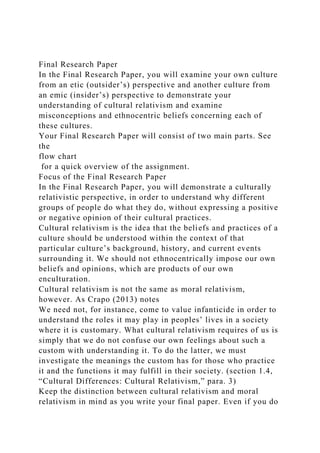
Final Research PaperIn the Final Research Paper, you will examin.docx
- 1. Final Research Paper In the Final Research Paper, you will examine your own culture from an etic (outsider’s) perspective and another culture from an emic (insider’s) perspective to demonstrate your understanding of cultural relativism and examine misconceptions and ethnocentric beliefs concerning each of these cultures. Your Final Research Paper will consist of two main parts. See the flow chart for a quick overview of the assignment. Focus of the Final Research Paper In the Final Research Paper, you will demonstrate a culturally relativistic perspective, in order to understand why different groups of people do what they do, without expressing a positive or negative opinion of their cultural practices. Cultural relativism is the idea that the beliefs and practices of a culture should be understood within the context of that particular culture’s background, history, and current events surrounding it. We should not ethnocentrically impose our own beliefs and opinions, which are products of our own enculturation. Cultural relativism is not the same as moral relativism, however. As Crapo (2013) notes We need not, for instance, come to value infanticide in order to understand the roles it may play in peoples’ lives in a society where it is customary. What cultural relativism requires of us is simply that we do not confuse our own feelings about such a custom with understanding it. To do the latter, we must investigate the meanings the custom has for those who practice it and the functions it may fulfill in their society. (section 1.4, “Cultural Differences: Cultural Relativism,” para. 3) Keep the distinction between cultural relativism and moral relativism in mind as you write your final paper. Even if you do
- 2. not personally agree with a cultural practice, demonstrate your understanding of the practice in its cultural context. Avoid opinionated or judgmental language in your paper. Introduction Begin with an introductory paragraph that has a thesis statement at the end . The introduction should set up your topic, giving a preview and summary of the analysis you will present in the body of the paper. The thesis statement is the last sentence or two of the introduction and states what the main point structuring your paper will be. Part I Using the Miner (1956) article and the feedback you received from your instructor on your “Summarize Your Sources for the Final Research Paper” assignment in Week Three as a guide, describe one aspect of your own culture from an etic perspective. See the appropriate sections in the textbook , based on your chosen topic from Week Three, for information on how to approach your paper from an anthropological perspective. You can describe American culture in general, as Miner does, or you can describe an American subculture, such as a specific geographical group (e.g., New Yorkers), a particular ethnicity (e.g., African Americans), or an age-related category of Americans (e.g., millennials). Use reputable statistics and/or scholarly research to support any factual statements. Do not rely solely on personal experience or opinion. Here is an example of how to properly support your statements . Potential sources you can use to support your analysis are listed below. You can also conduct your own research to find
- 3. other sources. United States Census Bureau ( http://www.census.gov/ ) Gallup ( http://www.gallup.com/home.aspx ) Pew Research Center ( http://www.pewresearch.org/ ) Part II Refer to the article you chose for Part II of the “Summarize Your Sources for the Final Research Paper” assignment in Week Three and describe an aspect of another culture from an emic (insider’s) perspective. You do not have to do research beyond reading your chosen article; however, if you do choose to conduct additional research make sure to use reputable statistics and/or scholarly sources to support any factual statements. Do not rely solely upon personal experience or opinion. Conclusion End with a concluding paragraph that reinforces your thesis. Summarize and tie together your main points for the reader. Provide a brief self-reflexive analysis of what you learned while writing this paper. Writing the Final Research Paper The Final Research Paper Must be five to six double-spaced pages in length (excluding title page and references page, meaning it will be seven to eight pages total), and formatted according to APA style as outlined in the Ashford Writing Center (see the
- 4. APA Essay Checklist for Students ). Must include a title page with the following: Title of paper Student’s name Course name and number Instructor’s name Date submitted Must begin with an introductory paragraph that has a succinct thesis statement. Must have well-structured body paragraphs with clear transitions from one topic to the next. Incorporate in-text citations from your scholarly sources to support your analysis throughout the paper. Must describe an aspect of your own culture from an etic perspective for Part I. Must describe an aspect of another culture from an emic perspective for Part II. Must demonstrate a perspective of cultural relativism throughout, avoiding judgmental and opinionated language. Must end with a conclusion that that reinforces the thesis and provides a self-reflexive analysis. Must use at least one scholarly resources in addition to the textbook, the Miner article, and the article chosen from the list in Part II of the Week Three assignment. Must document all sources in APA style in the body of the paper and on the references page as outlined in the Ashford Writing Center. Must include a separate references page that is formatted according to APA style as outlined in the Ashford Writing Center. In this class, you have three tutoring services available: Paper
- 5. Review, Live Chat, and Tutor E-mail. Click on the Writing Center (AWC) tab in the left-navigation menu to learn more about these tutoring options and how to get help with your writing.